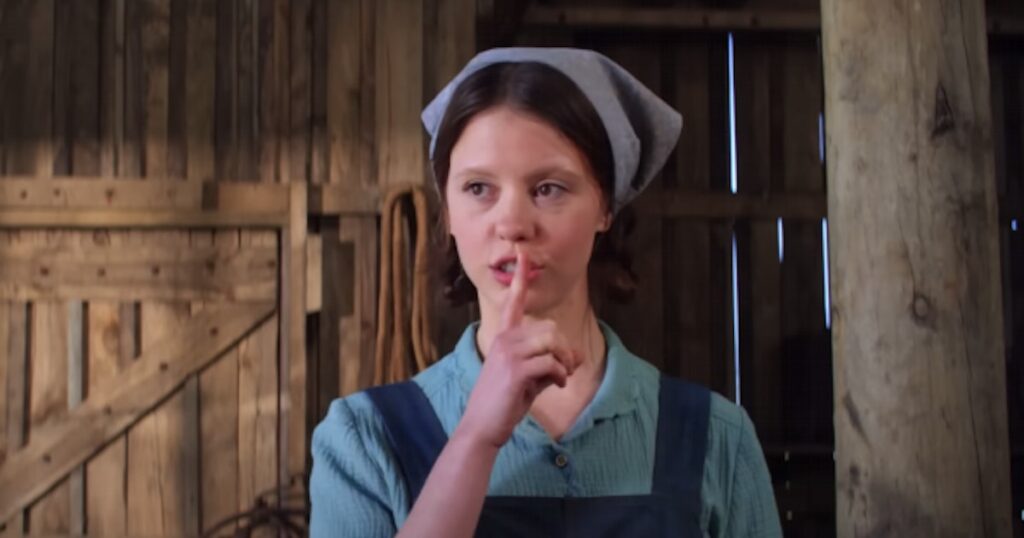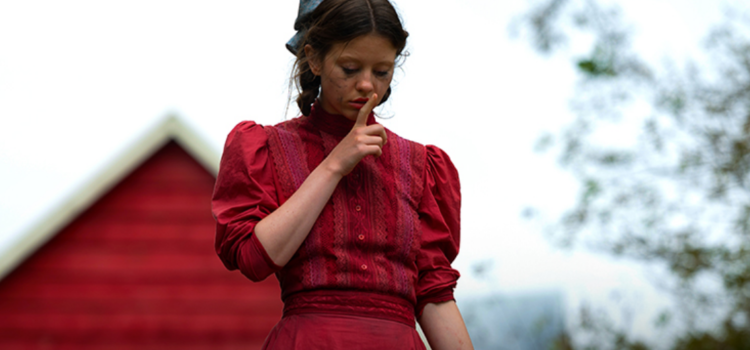By Alex McPherson
Bolstered by a towering performance from Mia Goth, director Ti West’s “Pearl” is a captivating, upsetting, and idiosyncratic horror drama that rivals the brilliance of “X” while standing on its own as a discomforting character study.
Described as a prequel to West’s “X,” released this spring, “Pearl” takes place in rural Texas during the height of the 1918 Spanish Flu epidemic. A young woman named Pearl (Goth) lives on a homestead with her domineering mother, Ruth (Tandi Wright), and her ailing father (Matthew Sunderland), who cannot move or speak and requires constant attention. Pearl’s husband, Howard, is overseas fighting in the first World War, leaving Pearl confined to the farm with only cows, geese, and one very hungry reptile to keep her company. She dreams of becoming a movie star and leaving her former life behind to chase fame and glory, to Ruth’s disdain.
But all’s not well in paradise. During the film’s hyper-stylized introduction — complete with a sweeping orchestral score, title cards, and camerawork showcasing an idyllic environment bursting with vivid colors with the sun beaming above (the same farm from “X,” in fact, immediately prompting uneasiness) — Pearl dances before an audience of farm animals… only to be interrupted by a goose who waddles into the barn. She calmly stabs it with a pitchfork and feeds it to her “pet” crocodile in the nearby swamp, as one does.
Not allowed to leave the farm, except to pick up medicine for her father, Pearl nevertheless stops by the cinema in town and becomes enraptured by the dancers on screen. She bumps into the charismatic yet manipulative projectionist (David Corenswet), who insists that she’s got what it takes to be up there one day. Pearl’s sister-in-law, Misty (Emma Jenkins-Purro), stops by with her mother to drop off a roast suckling pig — which Ruth refuses to accept, leaving the gnats to consume it on the front porch — and informs Pearl of tryouts for a local dancing troupe, potentially giving her the chance to finally prove her talent. With her heart racing and Ruth growing increasingly hostile, tensions continue to escalate, reaching a fever pitch that results in copious amounts of blood, sweat, and tears, as Pearl most certainly will not take no for an answer.
Eschewing the throwback ‘70s thrills of “X,” “Pearl” works as a poignant, legitimately disturbing drama, where viewers are encouraged to understand what drives its troubled heroine to murder, all while encountering three-dimensional characters that live and die in shades of gray (and red).
From the very beginning, West establishes an off-kilter world of juxtaposition and the harmless-turned-sinister. “Pearl” resembles a technicolor dreamscape popping with color and warm hues, belying a dark heart — grafting grotesque displays of violence, mental illness, and the absolute darkest humor onto bucolic surroundings. The glossy haze of Old Hollywood combines with sparkles of Pearl’s demented edges — lurid fever-dream hallucinations, victims’ faces reappearing unexpectedly — to chilling effect.
The true star of “Pearl,” though, is Goth (also a producer and co-writer), who imbues a devastating sense of humanity into the character — everything always seems genuine, from heartbreak to fearsome outbursts. Pearl, despite her exaggerated actions, still feels like a grounded human being, held back by her parents and destructive proclivities, attempting to seize a moment to break free from her restrictive world and essentially be reborn. Goth is astonishing, conjuring feelings of sorrow and disquietude in equal measure. One six-minute-plus monologue near the finale, for example, is one of the best acting showcases of 2022 thus far. Viewers witness Pearl experience an unpredictable storm of emotions, emerging as broken and as frightening as ever. Indeed, West isn’t afraid to plant the camera for extended dialogue-driven scenes, where viewers observe her transformation from jovial and upbeat to hurt and volatile first-hand. It’s both dreadfully suspenseful and darkly funny.
The side characters are also given unexpected depth. Ruth, a German immigrant who’s had to sacrifice to provide for the family (caring for her sick husband, who she can never abandon, and guarding against the virus raging everywhere), is weathered by trauma — projecting her insecurities onto Pearl, while also being unsure how to ultimately keep her under control. One fraught dinner sequence in particular, largely lit by flashes of lightning, positions her as a villain — yet, here, again, “Pearl” eerily subverts expectations by putting us in Pearl’s headspace and breaking with a thornier reality.
Sunderland does so much with his eyes alone as Pearl’s father — a man imprisoned by illness, unwillingly trapping others to be guardians, and existing at the whims of their crumbling psyches. Jenkins-Purro is similarly strong as Misty, a poor soul too naive and clueless for her own good. Corenswet brings both a charm and sly malevolence to the unnamed projectionist with questionable intentions.
Like with “X,” West interrogates ideas of how ambition, youth, and delusion can warp and fragment, as well as the connection between sex and violence. Sex becomes another facet of Pearl’s extreme rebellion against her “world” and everyone within it, paired with vicious carnage.
Although the last moments leave a few too many unanswered questions, “Pearl” is brilliant for its empathy, scares, stylization, and top-notch acting all around. It’s a different beast than “X,” but even more memorable, and I can’t wait to see how this trilogy concludes.

“Pearl” is a 2022 horror movie directed by Ti West and starring Mia Goth, Matthew Sunderland, David Corenswet, Tandi Wright, and Emma Jenkins-Purro. It is rated R for some strong violence, gore, strong sexual content and graphic nudity and runtime is ` hour, 43 minutes. It opened in theaters on Sept. 16. Alex’s Grade: A+
Alex McPherson is an unabashed pop culture nerd and a member of the St. Louis Film Critics Association.

